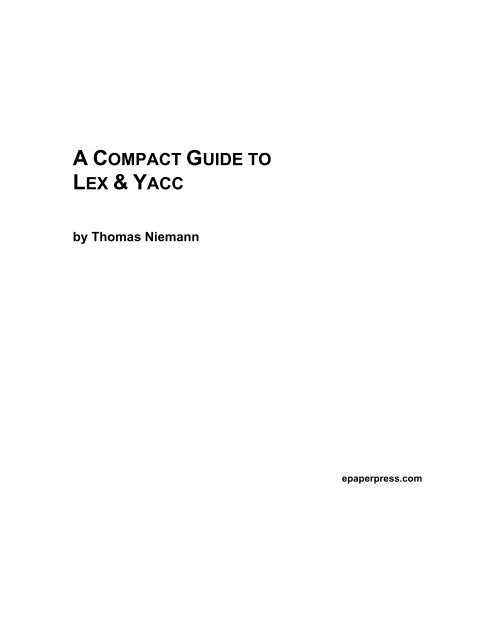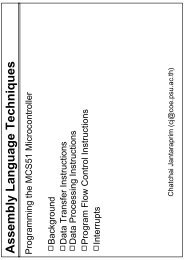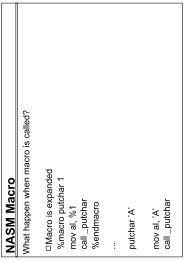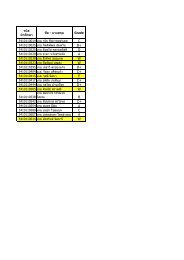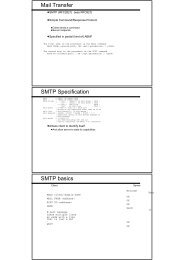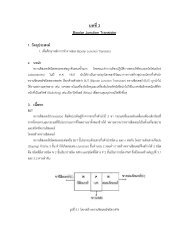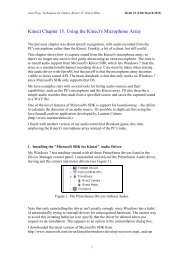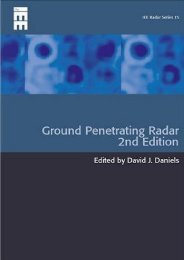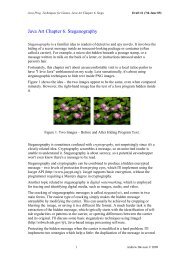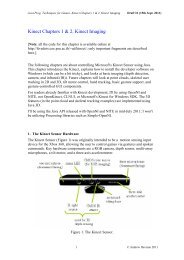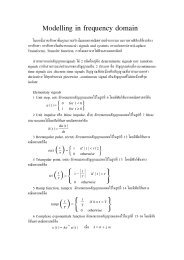LEX & YACC
LEX & YACC
LEX & YACC
Create successful ePaper yourself
Turn your PDF publications into a flip-book with our unique Google optimized e-Paper software.
A COMPACT GUIDE TO<strong>LEX</strong> & <strong>YACC</strong>by Thomas Niemannepaperpress.com
ContentsContents .......................................................................................................................................... 2Preface ............................................................................................................................................ 3Introduction...................................................................................................................................... 4Lex ................................................................................................................................................... 6Theory .......................................................................................................................................... 6Practice ........................................................................................................................................ 7Yacc............................................................................................................................................... 11Theory ........................................................................................................................................ 11Practice, Part I............................................................................................................................ 12Practice, Part II........................................................................................................................... 15Calculator....................................................................................................................................... 18Description ................................................................................................................................. 18Include File................................................................................................................................. 21Lex Input .................................................................................................................................... 22Yacc Input .................................................................................................................................. 23Interpreter................................................................................................................................... 26Compiler..................................................................................................................................... 27Graph ......................................................................................................................................... 29More Lex........................................................................................................................................ 33Strings ........................................................................................................................................ 33Reserved Words ........................................................................................................................ 34Debugging Lex........................................................................................................................... 34More Yacc...................................................................................................................................... 35Recursion................................................................................................................................... 35If-Else Ambiguity ........................................................................................................................ 35Error Messages.......................................................................................................................... 36Inherited Attributes..................................................................................................................... 37Embedded Actions..................................................................................................................... 37Debugging Yacc......................................................................................................................... 38Bibliography................................................................................................................................... 392
PrefaceThis document explains how to construct a compiler using lex and yacc. Lex and yacc are toolsused to generate lexical analyzers and parsers. I assume you can program in C, and understanddata structures such as linked-lists and trees.The introduction describes the basic building blocks of a compiler and explains the interactionbetween lex and yacc. The next two sections describe lex and yacc in more detail. With thisbackground, we construct a sophisticated calculator. Conventional arithmetic operations andcontrol statements, such as if-else and while, are implemented. With minor changes, we convertthe calculator into a compiler for a stack-based machine. The remaining sections discuss issuesthat commonly arise in compiler writing. Source code for examples may be downloaded from theweb site listed below.Permission to reproduce portions of this document is given provided the web site listed below isreferenced, and no additional restrictions apply. Source code, when part of a software project,may be used freely without reference to the author.THOMAS NIEMANNPortland, Oregonweb site:epaperpress.com3
IntroductionUntil 1975, writing a compiler was a very time-consuming process. Then Lesk [1975] andJohnson [1975] published papers on lex and yacc. These utilities greatly simplify compiler writing.Implementation details for lex and yacc may be found in Aho [1986]. Lex and yacc are availablefrom• Mortice Kern Systems (MKS), at www.mks.com,• GNU flex and bison, at www.gnu.org,• Ming, at www.mingw.org,• Cygwin, at www.cygwin.com, and• my version of Lex and Yacc, at epaperpress.com.The version from MKS is a high-quality commercial product that retails for about $300US. GNUsoftware is free. Output from flex may be used in a commercial product, and, as of version 1.24,the same is true for bison. Ming and Cygwin are 32-bit Windows ports of the GNU software. Infact Cygwin is a port of the Unix operating system to Windows, complete with compilers gcc andg++.My version is based on Ming’s, but is compiled with Visual C++ and includes a minor bug fix inthe file handling routine. If you download my version, be sure to retain directory structure whenyou unzip.source codea = b + c * dLexical Analyzertokensid1 = id2 + id3 * id4Syntax Analyzersyntax treeid1=id2+*id3id4Code Generatorgenerated codeloadmuladdstoreid3id4id2id1Figure 1: Compilation Sequence4
Lex generates C code for a lexical analyzer, or scanner. It uses patterns that match strings in theinput and converts the strings to tokens. Tokens are numerical representations of strings, andsimplify processing. This is illustrated in Figure 1.As lex finds identifiers in the input stream, it enters them in a symbol table. The symbol table mayalso contain other information such as data type (integer or real) and location of the variable inmemory. All subsequent references to identifiers refer to the appropriate symbol table index.Yacc generates C code for a syntax analyzer, or parser. Yacc uses grammar rules that allow it toanalyze tokens from lex and create a syntax tree. A syntax tree imposes a hierarchical structureon tokens. For example, operator precedence and associativity are apparent in the syntax tree.The next step, code generation, does a depth-first walk of the syntax tree to generate code.Some compilers produce machine code, while others, as shown above, output assembly.bas.yyacc(yyparse)y.tab.csourcey.tab.hccbas.exebas.llexlex.yy.c(yylex)compiled outputFigure 2: Building a Compiler with Lex/YaccFigure 2 illustrates the file naming conventions used by lex and yacc. We'll assume our goal is towrite a BASIC compiler. First, we need to specify all pattern matching rules for lex (bas.l) andgrammar rules for yacc (bas.y). Commands to create our compiler, bas.exe, are listed below:yacc –d bas.ylex bas.lcc lex.yy.c y.tab.c –obas.exe# create y.tab.h, y.tab.c# create lex.yy.c# compile/linkYacc reads the grammar descriptions in bas.y and generates a parser, function yyparse, in filey.tab.c. Included in file bas.y are token declarations. The –d option causes yacc to generatedefinitions for tokens and place them in file y.tab.h. Lex reads the pattern descriptions in bas.l,includes file y.tab.h, and generates a lexical analyzer, function yylex, in file lex.yy.c.Finally, the lexer and parser are compiled and linked together to form the executable, bas.exe.From main, we call yyparse to run the compiler. Function yyparse automatically calls yylex toobtain each token.5
LexTheoryThe first phase in a compiler reads the input source and converts strings in the source to tokens.Using regular expressions, we can specify patterns to lex that allow it to scan and match stringsin the input. Each pattern in lex has an associated action. Typically an action returns a token,representing the matched string, for subsequent use by the parser. To begin with, however, wewill simply print the matched string rather than return a token value. We may scan for identifiersusing the regular expressionletter(letter|digit)*This pattern matches a string of characters that begins with a single letter, and is followed by zeroor more letters or digits. This example nicely illustrates operations allowed in regular expressions:• repetition, expressed by the “*” operator• alternation, expressed by the “|” operator• concatenationAny regular expression expressions may be expressed as a finite state automaton (FSA). We canrepresent an FSA using states, and transitions between states. There is one start state, and oneor more final or accepting states.letter or digitstartletterother0 1 2Figure 3: Finite State AutomatonIn Figure 3, state 0 is the start state, and state 2 is the accepting state. As characters are read,we make a transition from one state to another. When the first letter is read, we transition to state1. We remain in state 1 as more letters or digits are read. When we read a character other than aletter or digit, we transition to state 2, the accepting state. Any FSA may be expressed as acomputer program. For example, our 3-state machine is easily programmed:start: goto state0state0: read cif c = letter goto state1goto state0state1: read cif c = letter goto state1if c = digit goto state1goto state2state2: accept stringThis is the technique used by lex. Regular expressions are translated by lex to a computerprogram that mimics an FSA. Using the next input character, and current state, the next state iseasily determined by indexing into a computer-generated state table.6
Now we can easily understand some of lex’s limitations. For example, lex cannot be used torecognize nested structures such as parentheses. Nested structures are handled by incorporatinga stack. Whenever we encounter a “(”, we push it on the stack. When a “)” is encountered, wematch it with the top of the stack, and pop the stack. Lex, however, only has states andtransitions between states. Since it has no stack, it is not well suited for parsing nested structures.Yacc augments an FSA with a stack, and can process constructs such as parentheses with ease.The important thing is to use the right tool for the job. Lex is good at pattern matching. Yacc isappropriate for more challenging tasks.PracticeMetacharacter Matches. any character except newline\n newline* zero or more copies of the preceding expression+ one or more copies of the preceding expression? zero or one copy of the preceding expression^beginning of line$ end of linea|ba or b(ab)+ one or more copies of ab (grouping)"a+b" literal "a+b" (C escapes still work)[] character classTable 1: Pattern Matching PrimitivesExpression Matchesabcabcabc* ab abc abcc abccc ...abc+ abc abcc abccc ...a(bc)+ abc abcbc abcbcbc ...a(bc)? a abc[abc]one of: a, b, c[a-z]any letter, a-z[a\-z] one of: a, -, z[-az]one of: -, a, z[A-Za-z0-9]+ one or more alphanumeric characters[ \t\n]+ whitespace[^ab]anything except: a, b[a^b]one of: a, ^, b[a|b]one of: a, |, ba|bone of: a, bTable 2: Pattern Matching ExamplesRegular expressions in lex are composed of metacharacters (Table 1). Pattern matchingexamples are shown in Table 2. Within a character class, normal operators lose their meaning.Two operators allowed in a character class are the hyphen (“-”) and circumflex (“^”). When usedbetween two characters, the hyphen represents a range of characters. The circumflex, whenused as the first character, negates the expression. If two patterns match the same string, the7
longest match wins. In case both matches are the same length, then the first pattern listed isused.... definitions ...%%... rules ...%%... subroutines ...Input to Lex is divided into three sections, with %% dividing the sections. This is best illustratedby example. The first example is the shortest possible lex file:%%Input is copied to output, one character at a time. The first %% is always required, as there mustalways be a rules section. However, if we don’t specify any rules, then the default action is tomatch everything and copy it to output. Defaults for input and output are stdin and stdout,respectively. Here is the same example, with defaults explicitly coded:%%/* match everything except newline */. ECHO;/* match newline */\n ECHO;%%int yywrap(void) {return 1;}int main(void) {yylex();return 0;}Two patterns have been specified in the rules section. Each pattern must begin in column one.This is followed by whitespace (space, tab or newline), and an optional action associated with thepattern. The action may be a single C statement, or multiple C statements enclosed in braces.Anything not starting in column one is copied verbatim to the generated C file. We may takeadvantage of this behavior to specify comments in our lex file. In this example there are twopatterns, “.” and “\n”, with an ECHO action associated for each pattern. Several macros andvariables are predefined by lex. ECHO is a macro that writes code matched by the pattern. This isthe default action for any unmatched strings. Typically, ECHO is defined as:#define ECHO fwrite(yytext, yyleng, 1, yyout)Variable yytext is a pointer to the matched string (NULL-terminated), and yyleng is the length ofthe matched string. Variable yyout is the output file, and defaults to stdout. Function yywrap iscalled by lex when input is exhausted. Return 1 if you are done, or 0 if more processing isrequired. Every C program requires a main function. In this case, we simply call yylex, the mainentry-point for lex. Some implementations of lex include copies of main and yywrap in a library,eliminating the need to code them explicitly. This is why our first example, the shortest lexprogram, functioned properly.8
Nameint yylex(void)char *yytextyylengyylvalint yywrap(void)FILE *yyoutFILE *yyinINITIALBEGINECHOFunctioncall to invoke lexer, returns tokenpointer to matched stringlength of matched stringvalue associated with tokenwrapup, return 1 if done, 0 if not doneoutput fileinput fileinitial start conditioncondition switch start conditionwrite matched stringTable 3: Lex Predefined VariablesHere’s a program that does nothing at all. All input is matched, but no action is associated withany pattern, so there will be no output.%%.\nThe following example prepends line numbers to each line in a file. Some implementations of lexpredefine and calculate yylineno. The input file for lex is yyin, and defaults to stdin.%{int yylineno;%}%%^(.*)\n printf("%4d\t%s", ++yylineno, yytext);%%int main(int argc, char *argv[]) {yyin = fopen(argv[1], "r");yylex();fclose(yyin);}The definitions section is composed of substitutions, code, and start states. Code in thedefinitions section is simply copied as-is to the top of the generated C file, and must be bracketedwith “%{“ and “%}” markers. Substitutions simplify pattern-matching rules. For example, we maydefine digits and letters:digit [0-9]letter [A-Za-z]%{int count;%}%%/* match identifier */{letter}({letter}|{digit})* count++;%%int main(void) {yylex();printf("number of identifiers = %d\n", count);return 0;}9
Whitespace must separate the defining term and the associated expression. References tosubstitutions in the rules section are surrounded by braces ({letter}) to distinguish them fromliterals. When we have a match in the rules section, the associated C code is executed. Here is ascanner that counts the number of characters, words, and lines in a file (similar to Unix wc):%{int nchar, nword, nline;%}%%\n { nline++; nchar++; }[^ \t\n]+ { nword++, nchar += yyleng; }. { nchar++; }%%int main(void) {yylex();printf("%d\t%d\t%d\n", nchar, nword, nline);return 0;}10
YaccTheoryGrammars for yacc are described using a variant of Backus Naur Form (BNF). This techniquewas pioneered by John Backus and Peter Naur, and used to describe ALGOL60. A BNFgrammar can be used to express context-free languages. Most constructs in modernprogramming languages can be represented in BNF. For example, the grammar for anexpression that multiplies and adds numbers isE -> E + EE -> E * EE -> idThree productions have been specified. Terms that appear on the left-hand side (lhs) of aproduction, such as E (expression) are nonterminals. Terms such as id (identifier) are terminals(tokens returned by lex) and only appear on the right-hand side (rhs) of a production. Thisgrammar specifies that an expression may be the sum of two expressions, the product of twoexpressions, or an identifier. We can use this grammar to generate expressions:E -> E * E (r2)-> E * z (r3)-> E + E * z (r1)-> E + y * z (r3)-> x + y * z (r3)At each step we expanded a term, replacing the lhs of a production with the corresponding rhs.The numbers on the right indicate which rule applied. To parse an expression, we actually needto do the reverse operation. Instead of starting with a single nonterminal (start symbol) andgenerating an expression from a grammar, we need to reduce an expression to a singlenonterminal. This is known as bottom-up or shift-reduce parsing, and uses a stack for storingterms. Here is the same derivation, but in reverse order:1 . x + y * z shift2 x . + y * z reduce(r3)3 E . + y * z shift4 E + . y * z shift5 E + y . * z reduce(r3)6 E + E . * z shift7 E + E * . z shift8 E + E * z . reduce(r3)9 E + E * E . reduce(r2) emit multiply10 E + E . reduce(r1) emit add11 E . acceptTerms to the left of the dot are on the stack, while remaining input is to the right of the dot. Westart by shifting tokens onto the stack. When the top of the stack matches the rhs of a production,we replace the matched tokens on the stack with the lhs of the production. Conceptually, thematched tokens of the rhs are popped off the stack, and the lhs of the production is pushed onthe stack. The matched tokens are known as a handle, and we are reducing the handle to the lhsof the production. This process continues until we have shifted all input to the stack, and only thestarting nonterminal remains on the stack. In step 1 we shift the x to the stack. Step 2 applies ruler3 to the stack, changing x to E. We continue shifting and reducing, until a single nonterminal, thestart symbol, remains in the stack. In step 9, when we reduce rule r2, we emit the multiply11
instruction. Similarly, the add instruction is emitted in step 10. Thus, multiply has a higherprecedence than addition.Consider, however, the shift at step 6. Instead of shifting, we could have reduced, applying ruler1. This would result in addition having a higher precedence than multiplication. This is known asa shift-reduce conflict. Our grammar is ambiguous, as there is more than one possible derivationthat will yield the expression. In this case, operator precedence is affected. As another example,associativity in the ruleE -> E + Eis ambiguous, for we may recurse on the left or the right. To remedy the situation, we couldrewrite the grammar, or supply yacc with directives that indicate which operator has precedence.The latter method is simpler, and will be demonstrated in the practice section.The following grammar has a reduce-reduce conflict. With an id on the stack, we may reduce toT, or reduce to E.E -> TE -> idT -> idYacc takes a default action when there is a conflict. For shift-reduce conflicts, yacc will shift. Forreduce-reduce conflicts, it will use the first rule in the listing. It also issues a warning messagewhenever a conflict exists. The warnings may be suppressed by making the grammarunambiguous. Several methods for removing ambiguity will be presented in subsequent sections.Practice, Part I... definitions ...%%... rules ...%%... subroutines ...Input to yacc is divided into three sections. The definitions section consists of token declarations,and C code bracketed by “%{“ and “%}”. The BNF grammar is placed in the rules section, anduser subroutines are added in the subroutines section.This is best illustrated by constructing a small calculator that can add and subtract numbers. We’llbegin by examining the linkage between lex and yacc. Here is the definitions section for the yaccinput file:%token INTEGERThis definition declares an INTEGER token. When we run yacc, it generates a parser in filey.tab.c, and also creates an include file, y.tab.h:#ifndef YYSTYPE#define YYSTYPE int#endif#define INTEGER 258extern YYSTYPE yylval;12
Lex includes this file and utilizes the definitions for token values. To obtain tokens, yacc callsyylex. Function yylex has a return type of int, and returns the token. Values associated with thetoken are returned by lex in variable yylval. For example,[0-9]+ {}yylval = atoi(yytext);return INTEGER;would store the value of the integer in yylval, and return token INTEGER to yacc. The type ofyylval is determined by YYSTYPE. Since the default type is integer, this works well in this case.Token values 0-255 are reserved for character values. For example, if you had a rule such as[-+] return *yytext; /* return operator */the character value for minus or plus is returned. Note that we placed the minus sign first so thatit wouldn’t be mistaken for a range designator. Generated token values typically start around 258,as lex reserves several values for end-of-file and error processing. Here is the complete lex inputspecification for our calculator:%{#include void yyerror(char *);#include "y.tab.h"%}%%[0-9]+ {}yylval = atoi(yytext);return INTEGER;[-+\n]return *yytext;[ \t] ; /* skip whitespace */. yyerror("invalid character");%%int yywrap(void) {return 1;}Internally, yacc maintains two stacks in memory; a parse stack and a value stack. The parsestack contains terminals and nonterminals, and represents the current parsing state. The valuestack is an array of YYSTYPE elements, and associates a value with each element in the parsestack. For example, when lex returns an INTEGER token, yacc shifts this token to the parsestack. At the same time, the corresponding yylval is shifted to the value stack. The parse andvalue stacks are always synchronized, so finding a value related to a token on the stack is easilyaccomplished. Here is the yacc input specification for our calculator:13
%{%}int yylex(void);void yyerror(char *);%token INTEGER%%program:program expr '\n' { printf("%d\n", $2); }|;expr:INTEGER { $$ = $1; }| expr '+' expr { $$ = $1 + $3; }| expr '-' expr { $$ = $1 - $3; };%%void yyerror(char *s) {fprintf(stderr, "%s\n", s);return 0;}int main(void) {yyparse();return 0;}The rules section resembles the BNF grammar discussed earlier. The left-hand side of aproduction, or nonterminal, is entered left-justified, followed by a colon. This is followed by theright-hand side of the production. Actions associated with a rule are entered in braces.By utilizing left-recursion, we have specified that a program consists of zero or more expressions.Each expression terminates with a newline. When a newline is detected, we print the value of theexpression. When we apply the ruleexpr: expr '+' expr { $$ = $1 + $3; }we replace the right-hand side of the production in the parse stack with the left-hand side of thesame production. In this case, we pop “expr '+' expr” and push “expr”. We have reduced thestack by popping three terms off the stack, and pushing back one term. We may referencepositions in the value stack in our C code by specifying “$1” for the first term on the right-handside of the production, “$2” for the second, and so on. “$$” designates the top of the stack afterreduction has taken place. The above action adds the value associated with two expressions,pops three terms off the value stack, and pushes back a single sum. Thus, the parse and valuestacks remain synchronized.14
Numeric values are initially entered on the stack when we reduce from INTEGER to expr. AfterINTEGER is shifted to the stack, we apply the ruleexpr: INTEGER { $$ = $1; }The INTEGER token is popped off the parse stack, followed by a push of expr. For the valuestack, we pop the integer value off the stack, and then push it back on again. In other words, wedo nothing. In fact, this is the default action, and need not be specified. Finally, when a newline isencountered, the value associated with expr is printed.In the event of syntax errors, yacc calls the user-supplied function yyerror. If you need to modifythe interface to yyerror, you can alter the canned file that yacc includes to fit your needs. The lastfunction in our yacc specification is main … in case you were wondering where it was. Thisexample still has an ambiguous grammar. Yacc will issue shift-reduce warnings, but will stillprocess the grammar using shift as the default operation.Practice, Part IIIn this section we will extend the calculator from the previous section to incorporate some newfunctionality. New features include arithmetic operators multiply, and divide. Parentheses may beused to over-ride operator precedence, and single-character variables may be specified inassignment statements. The following illustrates sample input and calculator output:user: 3 * (4 + 5)calc: 27user: x = 3 * (4 + 5)user: y = 5user: xcalc: 27user: ycalc: 5user: x + 2*ycalc: 37The lexical analyzer returns VARIABLE and INTEGER tokens. For variables, yylval specifies anindex to sym, our symbol table. For this program, sym merely holds the value of the associatedvariable. When INTEGER tokens are returned, yylval contains the number scanned. Here is theinput specification for lex:%{%}#include void yyerror(char *);#include "y.tab.h"%%/* variables */[a-z] {yylval = *yytext - 'a';return VARIABLE;}/* integers */[0-9]+ {yylval = atoi(yytext);15
}return INTEGER;/* operators */[-+()=/*\n] { return *yytext; }/* skip whitespace */[ \t] ;/* anything else is an error */. yyerror("invalid character");%%int yywrap(void) {return 1;}The input specification for yacc follows. The tokens for INTEGER and VARIABLE are utilized byyacc to create #defines in y.tab.h for use in lex. This is followed by definitions for the arithmeticoperators. We may specify %left, for left-associative, or %right, for right associative. The lastdefinition listed has the highest precedence. Thus, multiplication and division have higherprecedence than addition and subtraction. All four operators are left-associative. Using thissimple technique, we are able to disambiguate our grammar.%token INTEGER VARIABLE%left '+' '-'%left '*' '/'%{%}void yyerror(char *);int yylex(void);int sym[26];%%program:program statement '\n'|;statement:expr { printf("%d\n", $1); }| VARIABLE '=' expr { sym[$1] = $3; };expr:INTEGER| VARIABLE { $$ = sym[$1]; }| expr '+' expr { $$ = $1 + $3; }| expr '-' expr { $$ = $1 - $3; }| expr '*' expr { $$ = $1 * $3; }| expr '/' expr { $$ = $1 / $3; }| '(' expr ')' { $$ = $2; };16
%%void yyerror(char *s) {fprintf(stderr, "%s\n", s);return 0;}int main(void) {yyparse();return 0;}17
CalculatorDescriptionThis version of the calculator is substantially more complex than previous versions. Majorchanges include control constructs such as if-else and while. In addition, a syntax tree isconstructed during parsing. After parsing, we walk the syntax tree to produce output. Twoversions of the tree walk routine are supplied:• an interpreter that executes statements during the tree walk, and• a compiler that generates code for a hypothetical stack-based machine.To make things more concrete, here is a sample program,x = 0;while (x < 3) {print x;x = x + 1;}with output for the interpretive version,012and output for the compiler version, andpush 0pop xL000:push xpush 3compLTjz L001push xprintpush xpush 1addpop xjmp L000L001:18
a version that generates a syntax tree.Graph 0:[=]||----|| |id(X) c(0)Graph 1:while||----------------|| |[
Constants, variables, and nodes can be represented by yylval in the parser’s value stack. Noticethe type definitions%token INTEGER%type exprThis binds expr to nPtr, and INTEGER to iValue in the YYSTYPE union. This is required so thatyacc can generate the correct code. For example, the ruleexpr: INTEGER { $$ = con($1); }should generate the following code. Note that yyvsp[0] addresses the top of the value stack, orthe value associated with INTEGER.yylval.nPtr = con(yyvsp[0].iValue);The unary minus operator is given higher priority than binary operators as follows:%left GE LE EQ NE '>' '
Include Filetypedef enum { typeCon, typeId, typeOpr } nodeEnum;/* constants */typedef struct {int value; /* value of constant */} conNodeType;/* identifiers */typedef struct {int i; /* subscript to sym array */} idNodeType;/* operators */typedef struct {int oper; /* operator */int nops; /* number of operands */struct nodeTypeTag *op[1]; /* operands (expandable) */} oprNodeType;typedef struct nodeTypeTag {nodeEnum type; /* type of node *//* union must be last entry in nodeType *//* because operNodeType may dynamically increase */union {conNodeType con; /* constants */idNodeType id; /* identifiers */oprNodeType opr; /* operators */};} nodeType;extern int sym[26];21
Lex Input%{#include #include "calc3.h"#include "y.tab.h"void yyerror(char *);%}%%[a-z] {}[0-9]+ {}yylval.sIndex = *yytext - 'a';return VARIABLE;yylval.iValue = atoi(yytext);return INTEGER;[-()=+*/;{}.] {return *yytext;}">=" return GE;"
Yacc Input%{#include #include #include #include "calc3.h"/* prototypes */nodeType *opr(int oper, int nops, ...);nodeType *id(int i);nodeType *con(int value);void freeNode(nodeType *p);int ex(nodeType *p);int yylex(void);void yyerror(char *s);int sym[26]; /* symbol table */%}%union {int iValue; /* integer value */char sIndex; /* symbol table index */nodeType *nPtr; /* node pointer */};%token INTEGER%token VARIABLE%token WHILE IF PRINT%nonassoc IFX%nonassoc ELSE%left GE LE EQ NE '>' '
| VARIABLE '=' expr ';' { $$ = opr('=', 2, id($1), $3); }| WHILE '(' expr ')' stmt { $$ = opr(WHILE, 2, $3, $5); }| IF '(' expr ')' stmt %prec IFX { $$ = opr(IF, 2, $3, $5); }| IF '(' expr ')' stmt ELSE stmt{ $$ = opr(IF, 3, $3, $5, $7); }| '{' stmt_list '}' { $$ = $2; };stmt_list:stmt { $$ = $1; }| stmt_list stmt { $$ = opr(';', 2, $1, $2); };expr:INTEGER { $$ = con($1); }| VARIABLE { $$ = id($1); }| '-' expr %prec UMINUS { $$ = opr(UMINUS, 1, $2); }| expr '+' expr { $$ = opr('+', 2, $1, $3); }| expr '-' expr { $$ = opr('-', 2, $1, $3); }| expr '*' expr { $$ = opr('*', 2, $1, $3); }| expr '/' expr { $$ = opr('/', 2, $1, $3); }| expr '', 2, $1, $3); }| expr GE expr { $$ = opr(GE, 2, $1, $3); }| expr LE expr { $$ = opr(LE, 2, $1, $3); }| expr NE expr { $$ = opr(NE, 2, $1, $3); }| expr EQ expr { $$ = opr(EQ, 2, $1, $3); }| '(' expr ')' { $$ = $2; };%%#define SIZEOF_NODETYPE ((char *)&p->con - (char *)p)nodeType *con(int value) {nodeType *p;size_t nodeSize;/* allocate node */nodeSize = SIZEOF_NODETYPE + sizeof(conNodeType);if ((p = malloc(nodeSize)) == NULL)yyerror("out of memory");/* copy information */p->type = typeCon;p->con.value = value;}return p;nodeType *id(int i) {nodeType *p;size_t nodeSize;/* allocate node */nodeSize = SIZEOF_NODETYPE + sizeof(idNodeType);24
if ((p = malloc(nodeSize)) == NULL)yyerror("out of memory");/* copy information */p->type = typeId;p->id.i = i;}return p;nodeType *opr(int oper, int nops, ...) {va_list ap;nodeType *p;size_t nodeSize;int i;/* allocate node */nodeSize = SIZEOF_NODETYPE + sizeof(oprNodeType) +(nops - 1) * sizeof(nodeType*);if ((p = malloc(nodeSize)) == NULL)yyerror("out of memory");}/* copy information */p->type = typeOpr;p->opr.oper = oper;p->opr.nops = nops;va_start(ap, nops);for (i = 0; i < nops; i++)p->opr.op[i] = va_arg(ap, nodeType*);va_end(ap);return p;void freeNode(nodeType *p) {int i;}if (!p) return;if (p->type == typeOpr) {for (i = 0; i < p->opr.nops; i++)freeNode(p->opr.op[i]);}free (p);void yyerror(char *s) {fprintf(stdout, "%s\n", s);}int main(void) {yyparse();return 0;}25
Interpreter#include #include "calc3.h"#include "y.tab.h"int ex(nodeType *p) {if (!p) return 0;switch(p->type) {case typeCon: return p->con.value;case typeId: return sym[p->id.i];case typeOpr:switch(p->opr.oper) {case WHILE: while(ex(p->opr.op[0]))ex(p->opr.op[1]); return 0;case IF: if (ex(p->opr.op[0]))ex(p->opr.op[1]);else if (p->opr.nops > 2)ex(p->opr.op[2]);return 0;case PRINT: printf("%d\n", ex(p->opr.op[0]));}case ';':return 0;ex(p->opr.op[0]);return ex(p->opr.op[1]);case '=': return sym[p->opr.op[0]->id.i] =ex(p->opr.op[1]);case UMINUS: return -ex(p->opr.op[0]);case '+': return ex(p->opr.op[0]) + ex(p->opr.op[1]);case '-': return ex(p->opr.op[0]) - ex(p->opr.op[1]);case '*': return ex(p->opr.op[0]) * ex(p->opr.op[1]);case '/': return ex(p->opr.op[0]) / ex(p->opr.op[1]);case '': return ex(p->opr.op[0]) > ex(p->opr.op[1]);case GE: return ex(p->opr.op[0]) >= ex(p->opr.op[1]);case LE: return ex(p->opr.op[0]) opr.op[1]);case NE: return ex(p->opr.op[0]) != ex(p->opr.op[1]);case EQ: return ex(p->opr.op[0]) == ex(p->opr.op[1]);}}return 0;26
Compiler#include #include "calc3.h"#include "y.tab.h"static int lbl;int ex(nodeType *p) {int lbl1, lbl2;if (!p) return 0;switch(p->type) {case typeCon:printf("\tpush\t%d\n", p->con.value);break;case typeId:printf("\tpush\t%c\n", p->id.i + 'a');break;case typeOpr:switch(p->opr.oper) {case WHILE:printf("L%03d:\n", lbl1 = lbl++);ex(p->opr.op[0]);printf("\tjz\tL%03d\n", lbl2 = lbl++);ex(p->opr.op[1]);printf("\tjmp\tL%03d\n", lbl1);printf("L%03d:\n", lbl2);break;case IF:ex(p->opr.op[0]);if (p->opr.nops > 2) {/* if else */printf("\tjz\tL%03d\n", lbl1 = lbl++);ex(p->opr.op[1]);printf("\tjmp\tL%03d\n", lbl2 = lbl++);printf("L%03d:\n", lbl1);ex(p->opr.op[2]);printf("L%03d:\n", lbl2);} else {/* if */printf("\tjz\tL%03d\n", lbl1 = lbl++);ex(p->opr.op[1]);printf("L%03d:\n", lbl1);}break;case PRINT:ex(p->opr.op[0]);printf("\tprint\n");break;27
}case '=':ex(p->opr.op[1]);printf("\tpop\t%c\n", p->opr.op[0]->id.i + 'a');break;case UMINUS:ex(p->opr.op[0]);printf("\tneg\n");break;default:ex(p->opr.op[0]);ex(p->opr.op[1]);switch(p->opr.oper) {case '+': printf("\tadd\n"); break;case '-': printf("\tsub\n"); break;case '*': printf("\tmul\n"); break;case '/': printf("\tdiv\n"); break;case '': printf("\tcompGT\n"); break;case GE: printf("\tcompGE\n"); break;case LE: printf("\tcompLE\n"); break;case NE: printf("\tcompNE\n"); break;case EQ: printf("\tcompEQ\n"); break;}}}return 0;28
Graph/* source code courtesy of Frank Thomas Braun */#include #include #include "calc3.h"#include "y.tab.h"int del = 1; /* distance of graph columns */int eps = 3; /* distance of graph lines *//* interface for drawing (can be replaced by "real" graphic using GD orother) */void graphInit (void);void graphFinish();void graphBox (char *s, int *w, int *h);void graphDrawBox (char *s, int c, int l);void graphDrawArrow (int c1, int l1, int c2, int l2);/* recursive drawing of the syntax tree */void exNode (nodeType *p, int c, int l, int *ce, int *cm);/***********************************************************//* main entry point of the manipulation of the syntax tree */int ex (nodeType *p) {int rte, rtm;}graphInit ();exNode (p, 0, 0, &rte, &rtm);graphFinish();return 0;/*c----cm---ce---->l leaf-info*/drawing of leaf-nodes/*c---------------cm--------------ce----> drawing of non-leaf-nodeslnode-info* |* ------------- ...----* | | |* v v v* child1 child2 ... child-n* che che che*cs cs cs cs**/29
void exNode( nodeType *p,int c, int l, /* start column and line of node */int *ce, int *cm /* resulting end column and mid of node */){int w, h; /* node width and height */char *s; /* node text */int cbar;/* "real" start column of node (centred abovesubnodes) */int k; /* child number */int che, chm; /* end column and mid of children */int cs; /* start column of children */char word[20]; /* extended node text */if (!p) return;strcpy (word, "???"); /* should never appear */s = word;switch(p->type) {case typeCon: sprintf (word, "c(%d)", p->con.value); break;case typeId: sprintf (word, "id(%c)", p->id.i + 'A'); break;case typeOpr:switch(p->opr.oper){case WHILE: s = "while"; break;case IF: s = "if"; break;}}break;case PRINT: s = "print"; break;case ';': s = "[;]"; break;case '=': s = "[=]"; break;case UMINUS: s = "[_]"; break;case '+': s = "[+]"; break;case '-': s = "[-]"; break;case '*': s = "[*]"; break;case '/': s = "[/]"; break;case '': s = "[>]"; break;case GE: s = "[>=]"; break;case LE: s = "[
* node has children */cs = c;for (k = 0; k < p->opr.nops; k++) {exNode (p->opr.op[k], cs, l+h+eps, &che, &chm);cs = che;}/* total node width */if (w < che - c) {cbar += (che - c - w) / 2;*ce = che;*cm = (c + che) / 2;}/* draw node */graphDrawBox (s, cbar, l);}/* draw arrows (not optimal: children are drawn a second time) */cs = c;for (k = 0; k < p->opr.nops; k++) {exNode (p->opr.op[k], cs, l+h+eps, &che, &chm);graphDrawArrow (*cm, l+h, chm, l+h+eps-1);cs = che;}/* interface for drawing */#define lmax 200#define cmax 200char graph[lmax][cmax]; /* array for ASCII-Graphic */int graphNumber = 0;void graphTest (int l, int c){ int ok;ok = 1;if (l < 0) ok = 0;if (l >= lmax) ok = 0;if (c < 0) ok = 0;if (c >= cmax) ok = 0;if (ok) return;printf ("\n+++error: l=%d, c=%d not in drawing rectangle 0, 0 ...%d, %d",l, c, lmax, cmax);exit (1);}void graphInit (void) {int i, j;for (i = 0; i < lmax; i++) {for (j = 0; j < cmax; j++) {graph[i][j] = ' ';}}}31
void graphFinish() {int i, j;for (i = 0; i < lmax; i++) {for (j = cmax-1; j > 0 && graph[i][j] == ' '; j--);graph[i][cmax-1] = 0;if (j < cmax-1) graph[i][j+1] = 0;if (graph[i][j] == ' ') graph[i][j] = 0;}for (i = lmax-1; i > 0 && graph[i][0] == 0; i--);printf ("\n\nGraph %d:\n", graphNumber++);for (j = 0; j
More LexStringsQuoted strings frequently appear in programming languages. Here is one way to match a string inlex:%{char *yylval;#include %}%%\"[^"\n]*["\n] {yylval = strdup(yytext+1);if (yylval[yyleng-2] != '"')warning("improperly terminated string");elseyylval[yyleng-2] = 0;printf("found '%s'\n", yylval);}The above example ensures that strings don’t cross line boundaries, and removes enclosingquotes. If we wish to add escape sequences, such as \n or \", start states simplify matters:%{char buf[100];char *s;%}%x STRING%%\" { BEGIN STRING; s = buf; }\\n { *s++ = '\n'; }\\t { *s++ = '\t'; }\\\" { *s++ = '\"'; }\" {*s = 0;BEGIN 0;printf("found '%s'\n", buf);}\n { printf("invalid string"); exit(1); }. { *s++ = *yytext; }Exclusive start state STRING is defined in the definition section. When the scanner detects aquote, the BEGIN macro shifts lex into the STRING state. Lex stays in the STRING state,recognizing only patterns that begin with , until another BEGIN is executed. Thus, wehave a mini-environment for scanning strings. When the trailing quote is recognized, we switchback to state 0, the initial state.33
Reserved WordsIf your program has a large collection of reserved words, it is more efficient to let lex simplymatch a string, and determine in your own code whether it is a variable or reserved word. Forexample, instead of coding"if""then""else"return IF;return THEN;return ELSE;{letter}({letter}|{digit})* {yylval.id = symLookup(yytext);return IDENTIFIER;}where symLookup returns an index into the symbol table, it is better to detect reserved wordsand identifiers simultaneously, as follows:{letter}({letter}|{digit})* {int i;}if ((i = resWord(yytext)) != 0)return (i);yylval.id = symLookup(yytext);return (IDENTIFIER);This technique significantly reduces the number of states required, and results in smaller scannertables.Debugging LexLex has facilities that enable debugging. This feature may vary with different versions of lex, soyou should consult documentation for details. The code generated by lex in file lex.yy.c includesdebugging statements that are enabled by specifying command-line option “-d”. Debug output inflex (a GNU version of lex) may be toggled on and off by setting yy_flex_debug. Output includesthe rule applied and corresponding matched text. If you’re running lex and yacc together, specifythe following in your yacc input file:extern int yy_flex_debug;int main(void) {yy_flex_debug = 1;yyparse();}Alternatively, you may write your own debug code by defining functions that display informationfor the token value, and each variant of the yylval union. This is illustrated in the followingexample. When DEBUG is defined, the debug functions take effect, and a trace of tokens andassociated values is displayed.%union {int ivalue;...};%{#ifdef DEBUG34
int dbgToken(int tok, char *s) {printf("token %s\n", s);return tok;}int dbgTokenIvalue(int tok, char *s) {printf("token %s (%d)\n", s, yylval.ivalue);return tok;}#define RETURN(x) return dbgToken(x, #x)#define RETURN_ivalue(x) return dbgTokenIvalue(x, #x)#else#define RETURN(x) return(x)#define RETURN_ivalue(x) return(x)#endif%}%%[0-9]+ {}yylval.ivalue = atoi(yytext);RETURN_ivalue(INTEGER);"if""else"RETURN(IF);RETURN(ELSE);More YaccRecursionWhen specifying a list, we may do so using left recursion,list:or right recursion:list:item| list ',' item;item| item ',' listIf right recursion is used, all items on the list are pushed on the stack. After the last item ispushed, we start reducing. With left recursion, we never have more than three terms on the stack,since we reduce as we go along. For this reason, it is advantageous to use left recursion.If-Else AmbiguityA shift-reduce conflict that frequently occurs involves the if-else construct. Assume we have thefollowing rules:stmt:IF expr stmt| IF expr stmt ELSE stmt35
...and the following state:IF expr stmt IF expr stmt . ELSE stmtWe need to decide if we should shift the ELSE, or reduce the IF expr stmt at the top of the stack.If we shift, then we haveIF expr stmt IF expr stmt . ELSE stmtIF expr stmt IF expr stmt ELSE . stmtIF expr stmt IF expr stmt ELSE stmt .IF expr stmt stmt .where the second ELSE is paired with the second IF. If we reduce, we haveIF expr stmt IF expr stmt . ELSE stmtIF expr stmt stmt . ELSE stmtIF expr stmt . ELSE stmtIF expr stmt ELSE . stmtIF expr stmt ELSE stmt .where the second ELSE is paired with the first IF. Modern programming languages pair an ELSEwith the most recent unpaired IF, so the former behavior is expected. This works well with yacc,since default behavior, when a shift-reduce conflict is encountered, is to shift.Although yacc does the right thing, it also issues a shift-reduce warning message. To remove themessage, give IF-ELSE a higher precedence than the simple IF statement:%nonassoc IFX%nonassoc ELSEstmt:IF expr stmt %prec IFX| IF expr stmt ELSE stmtError MessagesA nice compiler gives the user meaningful error messages. For example, not much information isconveyed by the following message:syntax errorIf we track the line number in lex, then we can at least give the user a line number:void yyerror(char *s) {fprintf(stderr, "line %d: %s\n", yylineno, s);}When yacc discovers a parsing error, default action is to call yyerror, and then return from yylexwith a return value of one. A more graceful action flushes the input stream to a statementdelimiter, and continues to scan:stmt:';'36
| expr ';'| PRINT expr ';'| VARIABLE '=' expr ';| WHILE '(' expr ')' stmt| IF '(' expr ')' stmt %prec IFX| IF '(' expr ')' stmt ELSE stmt| '{' stmt_list '}'| error ';'| error '}';The error token is a special feature of yacc that will match all input until the token following erroris found. For this example, when yacc detects an error in a statement it will call yyerror, flushinput up to the next semicolon or brace, and resume scanning.Inherited AttributesThe examples so far have used synthesized attributes. At any point in a syntax tree we candetermine the attributes of a node based on the attributes of its children. Consider the ruleexpr: expr '+' expr { $$ = $1 + $3; }Since we are parsing bottom-up, the values of both operands are available, and we candetermine the value associated with the left-hand side. An inherited attribute of a node dependson the value of a parent or sibling node. The following grammar defines a C variable declaration:decl: type varlisttype: INT | FLOATvarlist:VAR { setType($1, $0); }| varlist ',' VAR { setType($3, $0); }Here is a sample parse:. INT VARINT . VARtype . VARtype VAR .type varlist .decl .When we reduce VAR to varlist, we should annotate the symbol table with the type of thevariable. However, the type is buried in the stack. This problem is resolved by indexing back intothe stack. Recall that $1 designates the first term on the right-hand side. We can indexbackwards, using $0, $-1, and so on. In this case, $0 will do just fine. If you need to specify atoken type, the syntax is $0, angle brackets included. In this particular example,care must be taken to ensure that type always precedes varlist.Embedded ActionsRules in yacc may contain embedded actions:list: item1 { do_item1($1); } item2 { do_item2($3); } item3Note that the actions take a slot in the stack, so do_item2 must use $3 to reference item2.Actually, this grammar is transformed by yacc into the following:37
list: item1 _rule01 item2 _rule02 item3_rule01: { do_item1($0); }_rule02: { do_item2($0); }Debugging YaccYacc has facilities that enable debugging. This feature may vary with different versions of yacc,so you should consult documentation for details. The code generated by yacc in file y.tab.cincludes debugging statements that are enabled by defining YYDEBUG and setting it to a nonzerovalue. This may also be done by specifying command-line option “-t”. With YYDEBUGproperly set, debug output may be toggled on and off by setting yydebug. Output includes tokensscanned and shift/reduce actions.%{#define YYDEBUG 1%}%%...%%int main(void) {#if YYDEBUGyydebug = 1;#endifyylex();}In addition, you can dump the parse states by specifying command-line option "-v". States aredumped to file y.output, and are often useful when debugging a grammar. Alternatively, you canwrite your own debug code by defining a TRACE macro, as illustrated below. When DEBUG isdefined, a trace of reductions, by line number, is displayed.%{#ifdef DEBUG#define TRACE printf("reduce at line %d\n", __LINE__);#else#define TRACE#endif%}%%statement_list:statement{ TRACE $$ = $1; }| statement_list statement{ TRACE $$ = newNode(';', 2, $1, $2); };38
BibliographyAho, Alfred V., Ravi Sethi and Jeffrey D. Ullman [1986]. Compilers, Prinicples, Techniques andTools. Addison-Wesley, Reading, Massachusetts.Gardner, Jim, Chris Retterath and Eric Gisin [1988]. MKS Lex & Yacc. Mortice Kern Systems Inc.,Waterloo, Ontario, Canada.Johnson, Stephen C. [1975]. Yacc: Yet Another Compiler Compiler. Computing ScienceTechnical Report No. 32, Bell Laboratories, Murray hill, New Jersey. A PDF version is available atePaperPress.Lesk, M. E. and E. Schmidt [1975]. Lex – A Lexical Analyzer Generator. Computing ScienceTechnical Report No. 39, Bell Laboratories, Murray Hill, New Jersey. A PDF version is availableat ePaperPress.Levine, John R., Tony Mason and Doug Brown [1992]. Lex & Yacc. O’Reilly & Associates, Inc.Sebastopol, California.39


